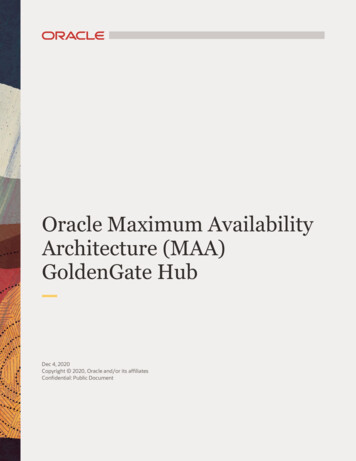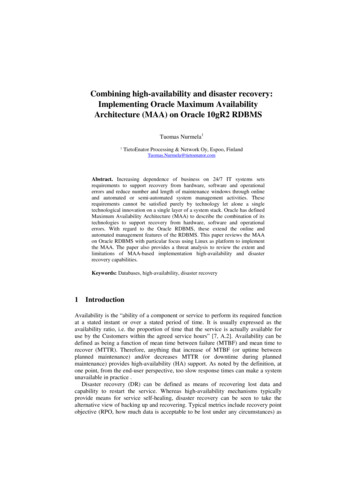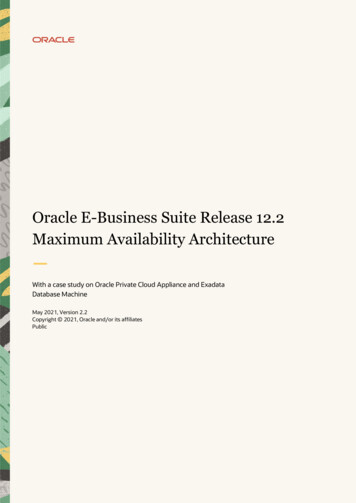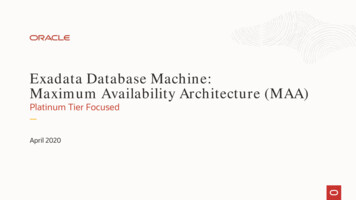
Transcription
Oracle Maximum AvailabilityArchitecture (MAA)GoldenGate HubDec 4, 2020Copyright 2020, Oracle and/or its affiliatesConfidential: Public Document
DISCLAIMERThis document in any form, software or printed matter, contains proprietaryinformation that is the exclusive property of Oracle. Your access to and use of thisconfidential material is subject to the terms and conditions of your Oracle softwarelicense and service agreement, which has been executed and with which you agree tocomply. This document and information contained herein may not be disclosed,copied, reproduced or distributed to anyone outside Oracle without prior writtenconsent of Oracle. This document is not part of your license agreement nor can it beincorporated into any contractual agreement with Oracle or its subsidiaries oraffiliates.This document is for informational purposes only and is intended solely to assist youin planning for the implementation and upgrade of the product features described. Itis not a commitment to deliver any material, code, or functionality, and should not berelied upon in making purchasing decisions. The development, release, and timing ofany features or functionality described in this document remains at the solediscretion of Oracle.Due to the nature of the product architecture, it may not be possible to safely includeall features described in this document without risking significant destabilization ofthe code.1Technical Brief Oracle Maximum Availability Architecture (MAA) GoldenGate HubCopyright 2020, Oracle and/or its affiliates Public Document
TABLE OF CONTENTSDisclaimer1Purpose Statement & Intended Audience3Introduction3Configuration Overview5Oracle GoldenGate5GoldenGate Hub6GoldenGate Hub MAA6NGINX Reverse Proxy Server8Naming Conventions Used Throughout This Paper8Configuration Prerequisites9Database Patch Requirements9Database Configuration for GoldenGate9GoldenGate Database Administrator Account10Create Database Role Based Service11Oracle Net Services Connectivity11GoldenGate Hub ConfigurationStep 1 - Install Oracle Grid Infrastructure 19c Software1213Step 2 - Install Oracle Client Software13Step 3 - Install GoldenGate Software14Step 4 - Install Oracle Standalone Agent Software14Step 5 - Install NGINX Reverse Proxy Server15Step 6 - Create Application Virtual IP Address16Step 7 - Configure ACFS File System Replication17Step 8 - Configure Initial GoldenGate Microservices Deployment25Step 9 - Create Additional GoldenGate Deployments30Step 10 - Register GoldenGate Deployments with Grid Infrastructure Standalone Agent31Step 11 - Configure NGINX Reverse Proxy33GoldenGate Configuration36Creating the Oracle Net Services Client Configuration Files36GoldenGate Extract Process Recommendations37Oracle Data Guard Data Loss Failover Considerations37GoldenGate Replicat Process Recommendations39GoldenGate Distribution Path Recommendations40Create Autostart Profiles41Monitoring GoldenGate Processes41Managing Planned and Unplanned Outages for The Goldengate Hub43Planned Outages43Unplanned Outages of the GoldenGate Hub45Conclusion47Appendix A: Example SSH Daemon Restart Action Script48Appendix B: acfs primary CRS Action Script50Appendix C: acfs standby CRS Action Script57Appendix D: Distribution Path Target Change Script62Appendix E: Example GoldenGate Deployment Creation Response Files64Appendix F: Troubleshooting672Troubleshooting ACFS Replication67Troubleshooting GoldenGate72Technical Brief Oracle Maximum Availability Architecture (MAA) GoldenGate HubCopyright 2020, Oracle and/or its affiliates Public Document
PURPOSE STATEMENT & INTENDED AUDIENCEThe intended audience for this document are individuals using Oracle GoldenGate or planning to use OracleGoldenGate. The document’s organization and content assumes familiarity with Oracle Database concepts but issuitable for both individuals well versed in Oracle GoldenGate as well as those that are new to Oracle GoldenGate andreplication concepts.The primary intent of this document is to provide education and guidance in regards to how best to configure aGoldenGate hub to be highly available and tolerant to disasters. Configuring Oracle GoldenGate as a hub is anarchitectural optimization to offload significant GoldenGate processing and management from the database servers.Ensuring that the hub uses Oracle MAA high availability and disaster recovery best practices is a key prerequisite to anMAA Platinum reference architecture. For more information about MAA platinum solution, see the Oracle Exadata MAA- Platinum Tier Focused Presentation at tinum-focused.pdf.This paper does not apply to Oracle Cloud Infrastructure (OCI) Marketplace environment.INTRODUCTIONTo achieve the highest levels of availability, resulting in zero or near-zero downtime for both unplanned outages andplanned maintenance activities, customers frequently use the combination of Oracle Real Application Clusters (OracleRAC), Oracle Active Data Guard, and Oracle GoldenGate. Traditionally, Oracle GoldenGate is installed and run locallyon the database server that the GoldenGate processes connect to. When used with Oracle Grid InfrastructureStandalone Agent (XAG), Oracle GoldenGate processes can be configured to seamlessly relocate or fail over betweenOracle RAC nodes and follow Oracle Active Data Guard switchover and failovers.Using Oracle GoldenGate in a hub configuration moves the GoldenGate software and processes off of the databaseserver, and places them on a separate server located close on the network to the target database. Connectivitybetween the GoldenGate processes and the databases they operate against is managed with Oracle Net Services.The Oracle GoldenGate hub configuration provides the following advantages: Cross-database versions support Cross-platform or cross-endianness support. The source database can be a different platform from the GoldenGatehub (e.g. IBM AIX source database host and Linux GoldenGate hub) Offload Oracle GoldenGate software installation, configuration and life cycle management from source and targetdatabase systems Reduced Oracle GoldenGate resource impact on the source and target database systems Support for multiple source and target databases replicating data concurrently More than one hub may be used if necessary or for performance reasons (i.e. bi-directional replication betweendatabases in different continents)3Technical Brief Oracle Maximum Availability Architecture (MAA) GoldenGate HubCopyright 2020, Oracle and/or its affiliates Public Document
Configuring the hub with Maximum Availability Architecture principles in mind, it is possible to create a standby hub thatwill become the primary hub in the event of a site failure.4Technical Brief Oracle Maximum Availability Architecture (MAA) GoldenGate HubCopyright 2020, Oracle and/or its affiliates Public Document
CONFIGURATION OVERVIEWThis section introduces the main components of the Oracle GoldenGate hub in an MAA configuration using the GoldenGateMicroservices Architecture.Oracle GoldenGateGoldenGate provides real-time, log-based change data capture and delivery between homogenous and heterogeneous systems. Thistechnology enables you to construct a cost-effective and low-impact real-time data integration and continuous availability solution.GoldenGate replicates data from committed transactions with transaction integrity and minimal overhead on your existing infrastructure.The architecture supports multiple data replication topologies such as one-to-many, many-to-many, cascading, and bidirectional. Itswide variety of use cases includes real-time business intelligence; query offloading; zero-downtime upgrades and migrations; andactive-active databases for data distribution, data synchronization, and high availability.GoldenGate Microservices Architecture was introduced in GoldenGate release 12.3, as a new administration architecture that providesREST-enabled services as part of the GoldenGate environment. The REST-enabled services provide remote configuration,administration, and monitoring through HTML5 web pages, command-line interfaces, and APIs. Figure 1 shows the GoldenGateMicroservices Architecture.Figure 1: GoldenGate Microservices Architecture5Technical Brief Oracle Maximum Availability Architecture (MAA) GoldenGate HubCopyright 2020, Oracle and/or its affiliates Public Document
More information about GoldenGate Microservices Architecture can be found in the GoldenGate documentation denGate HubThe GoldenGate Hub is an architectural concept that places the GoldenGate software on a different host than the databases beingoperated against, as shown in Figure 2. The hub must be in close network proximity to the target database with the expectation thatnetwork latency should never exceed 2-3ms, or typically less than 50 kilometers. One advantage of this architecture is that it isolatesmost of the GoldenGate resource usage from the source and target database servers enabling more system resources for applicationand database processing. Another advantage is that the GoldenGate configuration is simplified significantly by administering andmonitoring the entire GoldenGate infrastructure from a self contained single server, without the need of accessing separate GoldenGateinstallations on each database server.Figure 2: GoldenGate Hub architectureGoldenGate Hub MAA6Technical Brief Oracle Maximum Availability Architecture (MAA) GoldenGate HubCopyright 2020, Oracle and/or its affiliates Public Document
In order to provide maximum availability for local and complete disaster failures for the hub, there are additional Oracle softwareconfiguration requirements that are shown below in Figure 3.Figure 3: Oracle GoldenGate Hub with MAAFigure 4 below shows how the GoldenGate hub changes after a data center failure in the environment.Figure 4: GoldenGate Hub after environment failuresThe key hub configuration pre-requisites are: Primary and Standby hub servers and target database servers have round trip latency of less 4ms. With bi-directional replication,or when there are multiple target databases in different data centers, it may be necessary to have additional hubs with distributionpaths sending trail files between them. Linux x86-64 Operating System on the hub servers.7Technical Brief Oracle Maximum Availability Architecture (MAA) GoldenGate HubCopyright 2020, Oracle and/or its affiliates Public Document
Oracle Grid Infrastructure 19c version 19.7 or higher. When deploying a new GoldenGate hub, it’s recommended to use the latestproduction Grid Infrastructure software.Oracle Grid Infrastructure provides the necessary components needed to manage high availability for any business-criticalapplications. Using Oracle Clusterware (a component of Oracle Grid Infrastructure) network, database and GoldenGate resourcescan be managed to provide availability in the event of a failure. This minimum release is required to provide the features forseamless integration of ACFS (ASM Cluster File System) Replication and GoldenGate. Oracle ACFS to store critical GoldenGate deployment files. Oracle ACFS Replication to replicate the critical GoldenGate files to the hub standby server. With ACFS Replication, changes tothe GoldenGate shared files, for example checkpoint and trail files, are automatically replicated to a standby file system. Oracle Grid Infrastructure Standalone Agent (XAG) version 10.2 or higher.The Oracle Grid Infrastructure Standalone Agent leverages the Oracle Grid Infrastructure components to provide integrationbetween GoldenGate and its dependent resources, such as the database, network and file system. The agent also integratesGoldenGate with Oracle Data Guard so that GoldenGate is restarted on the new primary database following a role transition. GoldenGate 19c version 19.1.0.0.4 Microservices or higher.GoldenGate Microservices Architecture provides REST-enabled services as part of the GoldenGate environment. The RESTenabled services provide remote configuration, administration, and monitoring through HTML5 web pages, command-lineinterfaces, and APIs.NGINX Reverse Proxy ServerThe GoldenGate reverse proxy feature allows a single point of contact for all of the GoldenGate microservices associated with anGoldenGate deployment. Without reverse proxy, the microservices are contacted using a URL consisting of a host name or IP addressand separate port numbers, one for each of the services. For example, to contact the Service Manager you could usehttp://gghub.example.com:9100, then the Administration Server might be http://gghub.example.com:9101, theadministration server of deployment #2 could be https://gghub.example.com:9111, and so on.With reverse proxy, port numbers are not required to connect to the microservices, as they are replaced with the deployment name.Using the previous example, to connect to the Service Manager use the URL https://gghub.example.com, the Admin Server ofdeployment #1 (named Source) would use https://gghub.example.com/SOURCE/adminsrvr, and the administration server ofdeployment #2 (named Target) would be https://gghub.example.com/TARGET/adminsrvr.Reverse proxy is recommended and used by default with GoldenGate from the Oracle Cloud Marketplace to ensure easy access tomicroservices and provide enhanced security and manageability.Configuration of the NGINX proxy server is covered later in this paper.Naming Conventions Used Throughout This PaperThroughout this paper, examples are provided for REST API endpoints to manage the GoldenGate configuration using twodeployments (SOURCE and TARGET). The REST API is used so that the commands can easily be integrated into an automatedconfiguration script. The script can be run locally or remotely from any server with access to the hub with curl and Python installed.Alternatively, you can use the GoldenGate Admin Client commands to manage the hub. Admin Client is a standalone command-lineinterface used to create and manage GoldenGate replication. Refer to the Command Line Interface Reference for GoldenGate forAdmin Client dengate/core/19.1/gclir/index.htmlHere is an example of key arguments given in the GoldenGate REST APIs used throughout this brief:8Technical Brief Oracle Maximum Availability Architecture (MAA) GoldenGate HubCopyright 2020, Oracle and/or its affiliates Public Document
curl -s –K access.cfg https:// GG Hub / DeploymentName /adminsrvr/services/v2/credentials/goldengate -XGET python -m json.tool access.cfg: To prevent the GoldenGate administrator account name and password from being exposed on the command line, it isrecommended that you include the user name and password in a configuration file, which is read by curl, as shown here.user "oggadmin:password" GG Hub: The hostname or IP address of the hub server. For example, gghub-server. Deployment Name: This is the name of the GoldenGate deployment. For example, SOURCE or TARGET.Example: curl -s –K vr/services/v2/credentials/goldengate -XGET python -mjson.toolThe example Extract name used in this paper is EXT1 and the Replicat is called REP1.The REST calls can be made from either the hub, or any machine, that can access the GoldenGate hub through the HTTPS protocol.CONFIGURATION PREREQUISITESDatabase Patch RequirementsThe minimum database version that is supported with GoldenGate is Oracle Database 11g Release 2 (11.2.0.4). It is a best practice toapply the latest bundle patch and PSU (Patch Set Update) on both the source and target databases. The full recommended patch listcan be found in My Oracle Support note 2193391.1, which covers database versions 11.2.0.4 onwards.It is recommended that you also apply patch 28849751 to the source database if network round trip latency between the sourcedatabase and hub is greater than 8ms, and if the latest database bundle patch or PS/CPU (Critical Patch Update) does not include it.To check if your current database software includes patch 28849751 run the following command. ORACLE HOME/OPatch/opatch lsinventory grep 2884975128803345, 28819640, 28849751, 28852691, 28856060, 28891984, 28951382Database Configuration for GoldenGateThe source database prerequisites are described in the MAA technical brief “Oracle GoldenGate Performance Best Practices” lability/maa-gg-performance-1969630.pdf. The key prerequisites are listed below.Source Database Prerequisites Enable ARCHIVELOG mode for the database. Enable database force logging to ensure that all changes are found in the redo by the GoldenGate Extract process. Enable database minimal supplemental logging. Additional schema level supplemental logging for replicated objects also required. Configure the streams pool with the initialization parameter STREAMS POOL SIZE. Enable GoldenGate replication by enabling the initialization parameter ENABLE GOLDENGATE REPLICATION. Install the UTL SPADV/UTL RPADV package for integrated Extract performance analysis.Target Database Prerequisites Enable GoldenGate replication by enabling the initialization parameter ENABLE GOLDENGATE REPLICATION.9Technical Brief Oracle Maximum Availability Architecture (MAA) GoldenGate HubCopyright 2020, Oracle and/or its affiliates Public Document
Configure the streams pool with the initialization parameter STREAMS POOL SIZE, if GoldenGate integrated parallel Replicat isused (refer to the section GoldenGate Replicat Process Recommendations). Install the UTL SPADV/UTL RPADV package for integrated Extract performance analysis.GoldenGate Database Administrator AccountIf the source database is currently part of a GoldenGate configuration the GoldenGate administrator account may already exist. If theuser already exists, you need to confirm the permissions are correctly granted, and if not grant them.If no GoldenGate database administrator user account exists, the user must be created. The recommended source database usernameis GGADMIN for single tenant and PDBs where not all PDBs are being replicated, and C##GGADMIN for a CDB database and PDBswhere a single PDB exists or all PDBs are being replicated. The target database recommended username is GGADMIN.If a GoldenGate administrator user already exists, it should be used for the database GoldenGate configuration. Make sure thepermissions listed below are granted to the current GoldenGate administrator account.Throughout this technical brief the database GoldenGate administrator account is named GGADMIN.Use the following example to create a new GoldenGate administrator account for a single tenant source database, a subset of PDBsthat exist in the multitenant database, and for the target database.SQL create user ggadmin identified by password default tablespace users temporary tablespace temp;SQL grant connect, resource to ggadmin;SQL grant select any dictionary to ggadmin;SQL grant create view to ggadmin;SQL grant execute on dbms lock to ggadmin;SQL exec dbms goldengate auth.GRANT ADMIN PRIVILEGE('ggadmin');If you are replicating all PDBs within a multitenant source database, use the following example command to create the common user inthe CDB and all PDBs:SQL create user c##ggadmin identified by password default tablespace users temporary tablespace temp CONTAINER ALL;SQL grant connect, resource to c##ggadmin CONTAINER ALL;SQL grant select any dictionary to ggadmin CONTAINER ALL;SQL grant create view to c##ggadmin CONTAINER ALL;SQL grant execute on dbms lock to c##ggadmin CONTAINER ALL;SQL exec dbms goldengate auth.GRANT ADMIN PRIVILEGE('c##ggadmin',container 'all');NOTE: The default and temporary tablespace names MUST exist in the CDB and all PDBs.If you are replicating a subset of the PDBs within a multitenant source database, use the following example command to create the userin the CDB:SQL create user c##ggadmin identified by password default tablespace users temporary tablespace temp;SQL grant connect, resource to c##ggadmin;SQL grant select any dictionary to ggadmin;SQL grant create view to c##ggadmin;SQL grant execute on dbms lock to c##ggadmin;SQL exec dbms goldengate auth.GRANT ADMIN PRIVILEGE('c##ggadmin',container ' PDB name ');10Technical Brief Oracle Maximum Availability Architecture (MAA) GoldenGate HubCopyright 2020, Oracle and/or its affiliates Public Document
Create Database Role Based ServiceIf the GoldenGate source and target databases are running the recommended configuration on an Oracle RAC cluster with Oracle DataGuard, a role-based service needs to be created that will allow the GoldenGate Extract or Replicat processes to connect to the correctData Guard primary database instance. Run the following command on both the primary and standby Data Guard clusters to create therole based service: srvctl add service -db database service name -service oggsource -role PRIMARY-preferred instance name 1 , instance name 2 Example: srvctl add service -db GGS2 -service oggsource -role PRIMARY -preferred GGS21,GGS22NOTE: A database service is still required if not using Oracle Data Guard, simply omit the -role PRIMARY parameter.The service should be started before GoldenGate is configured in a later step, using the following commands: srvctl status service -d GGS2 -s oggsource srvctl start service -d GGS2 -i GGS21 -s oggsourceNOTE: The role based service must be created on both the source and target database Data Guard primary and standby RAC clusters.Oracle Net Services ConnectivityOracle Net connectivity should be optimized to provide the best performance for the remote GoldenGate Extract running on the hub.It is recommended that you set the source database listener to use a higher SDU size to improve performance with a remoteGoldenGate Extract. Please note that even though the listener is set at the maximum possible SDU size, the smallest size is used ifrequested by the client. For example, if the listener sets SDU to 2MB but the client requests the default 8KB SDU, the connection to thedatabase uses an 8KB SDU size. The maximum value for the SDU size for Oracle Database 11g Release 2 is 64KB (65536 bytes), andfor later database releases the maximum value is 2MB (2097152 bytes).It is recommended that you use Oracle Net Services or Secure Sockets Layer (SSL) encryption for connections to the source database.Refer to the Oracle Database Security Guide for more information about SSL with Oracle 39-ADF4B840819FThe following example sqlnet.ora and listener.ora files are configured with SSL and an increased SDU size for OracleDatabase 12g Release 1 and later:sqlnet.oraSQLNET.IGNORE ANO ENCRYPTION FOR TCPS TRUESQLNET.WALLET OVERRIDE FALSESQLNET.EXPIRE TIME 10WALLET LOCATION (SOURCE (METHOD FILE)(METHOD DATA (DIRECTORY /u01/oracle/tcps wallets)))SSL VERSION 1.2# Parameters required for Net encryption if not using SSL Authentication, replacing# the above parameters:# SQLNET.ENCRYPTION SERVER accepted# SQLNET.ENCRYPTION TYPES SERVER (AES256)DEFAULT SDU SIZE 209715211Technical Brief Oracle Maximum Availability Architecture (MAA) GoldenGate HubCopyright 2020, Oracle and/or its affiliates Public Document
listener.oraGGSOURCE (DESCRIPTION LIST (DESCRIPTION (SDU 2097152)(ADDRESS (PROTOCOL TCPS)(HOST source database host )(PORT 2484))))SID LIST GGSOURCE (SID LIST (SID DESC (SDU 2097152)(SID NAME ORACLE SID )(ORACLE HOME ORACLE HOME )))If the source database is on Oracle RAC, configure the listener on all of the cluster nodes running instances for the database. This way,if one instance goes down, the service can migrate to a surviving instance. Configure the SSL wallet on all Oracle RAC nodes.To start, stop, and get the status of the listener, make sure the following environment variables are set and then issue the listedcommands:export ORACLE HOME oracle home directory export PATH PATH: ORACLE HOME/binexport TNS ADMIN TNS admin directory To start the listener: lsnrctl start GGSOURCETo stop the listener: lsnrctl stop GGSOURCETo get the current status of the listener: lsnrctl status GGSOURCEGOLDENGATE HUB CONFIGURATIONThe hub requires four software installations and configuration: Oracle Grid Infrastructure 19c, version 19.7 or higher Oracle Client Software to match source and target Oracle Database versions (minimum version is 11.2.0.4) GoldenGate software to match source and target Oracle Database versions NGINX reverse proxy server used by the GoldenGate Microservices deployment connectivityThe following sections provide details about the required software installations.NOTE: All instructions must be carried out on both the primary and standby hub servers.12Technical Brief Oracle Maximum Availability Architecture (MAA) GoldenGate HubCopyright 2020, Oracle and/or its affiliates Public Document
Step 1 - Install Oracle Grid Infrastructure 19c SoftwareAfter installing Oracle Grid Infrastructure 19c on both the primary and standby hub servers, download and apply the latest releaseupdate. The minimum required release update version is 19.7.You MUST apply patch 31697904 to the Oracle Grid Infrastructure software home to ensure that you have the latest ACFS replicationfunctionality to handle unplanned file system outages, which is required for the solution presented in this technical brief. This patch canbe downloaded from My Oracle Support.Step 2 - Install Oracle Client SoftwareGoldenGate requires libraries that are installed as part of the Oracle Client Runtime installation. The client software version installedmust be the same release number as the database that GoldenGate will connect to. For example, if the source is Oracle Database 12cRelease 2, and the target is Oracle Database 19c, two different client software installations are required:one for Oracle Database 12cand another for Oracle Database 19c. If the source and target database releases are the same, a single Oracle client softwareinstallation is required.If the source database is not running on the same operating system as the hub, install the GoldenGate software for the hub platformoperating system, which is Linux.NOTE: The Oracle Client Software MUST be installed in matching ORACLE HOME directories on both the primary and standby hubservers. Do NOT use the Oracle instant client software because it does not contain all of the required libraries.Download the Oracle client software from https://edelivery.oracle.com. On Oracle Software Delivery Cloud select the Release categoryand search for ”Oracle Database Client”.During installation, select the Runtime installation type, as shown in the example below.13Technical Brief Oracle Maximum Availability Architecture (MAA) GoldenGate HubCopyright 2020, Oracle and/or its affiliates Public Document
Figure 4: Oracle Client Software InstallationInstall the Oracle client software that matches both the source and target database releases into separate ORACLE HOME directories.Step 3 - Install GoldenGate SoftwareYou must install the GoldenGate software release that supports the source and target Oracle Database releases. The GoldenGatesoftware compatibility matrix can be found at downloads/fusion-certification100350.htmlDownload the latest GoldenGate software from dengate-downloads.html. It isrecommended that you install the latest available release of GoldenGate, which is currently 19c Release 1 (19.1.0.0.4). UsingGoldenGate 19c Release 1 allows the cross-endian extract where the operating system running GoldenGate Extract is a differentendianness from the source database platform.If the source and target database releases are different, make sure you install the GoldenGate software twice, once for each databaserelease. Below, Figure 5 shows the software installer option for the database releases.Figure 5. Select the GoldenGate release for your Oracle Database versionIt is important that you install the GoldenGate software in separate directories, based on the database version they support.NOTE: Make sure to place each GoldenGate software installation in the same directory path on each primary and standby Oracle RACnodes.Step 4 - Install Oracle Standalone Agent SoftwareThe following step-by-step procedure shows how to configure Oracle Clusterware to manage GoldenGate using the Oracle GridInfrastructure Standalone Agent (XAG). Using XAG automates the ACFS file system mounting, as well as the stopping and starting ofthe GoldenGate deployment when relocating between Oracle RAC nodes and Data Guard primary databases. Install the Oracle Grid Infrastructure Standalone Agent14Technical Brief Oracle Maximum Availability Architecture (MAA) GoldenGate HubCopyright 2020, Oracle and/or its affiliates Public Document
Download the latest XAG software from nloads-3636484.htmlWhen using GoldenGate Microservices Architecture, it is a requirement to use XAG version 10.2 or newer.The XAG software must be installed in a directory that is outside of the Oracle Grid Infrastructure home directory to avoid conflictswith software patching. XAG needs to be installed in the same directory path on all RAC nodes in the cluster where GoldenGate isinstalled.For example, as the oracle user: ./xagsetup.sh --install --directory /u01/oracle/xag --all nodes Add the location of the installed XAG software to the PATH variable so it gets set automatically for the oracle user.
GoldenGate hub to be highly available and tolerant to disasters. Configuring Oracle GoldenGate as a hub is an architectural optimization to offload significant GoldenGate processing and management from the database servers. Ensuring that the hub uses Oracle MAA high availability and disaster recovery best practices is a key prerequisite to an










